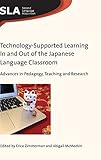Technology-Supported Learning In and Out of the Japanese Language Classroom : Advances in Pedagogy, Teaching and Research / ed. by Erica Zimmerman, Abigail McMeekin.
Material type: TextSeries: Second Language AcquisitionPublisher: Bristol ; Blue Ridge Summit : Multilingual Matters, [2019]Copyright date: ©2019Description: 1 online resourceContent type:
TextSeries: Second Language AcquisitionPublisher: Bristol ; Blue Ridge Summit : Multilingual Matters, [2019]Copyright date: ©2019Description: 1 online resourceContent type: - 9781788923507
- 9781788923514
- Japanese language -- Computer-assisted instruction for foreign speakers
- Japanese language -- Study and teaching -- Foreign speakers
- LANGUAGE ARTS & DISCIPLINES / Study & Teaching
- CALL
- Computer Assisted Language Learning
- JFL
- JSL
- Japanese as a second language
- Japanese pedagogy
- SLA
- collaborative online learning
- e-learning
- language acquisition
- teaching and learning Japanese
- technology-supported pedagogy
- 495.680078 23
- PL519 .T35 2019eb
- online - DeGruyter
| Item type | Current library | Call number | URL | Status | Notes | Barcode | |
|---|---|---|---|---|---|---|---|
 eBook
eBook
|
Biblioteca "Angelicum" Pont. Univ. S.Tommaso d'Aquino Nuvola online | online - DeGruyter (Browse shelf(Opens below)) | Online access | Not for loan (Accesso limitato) | Accesso per gli utenti autorizzati / Access for authorized users | (dgr)9781788923514 |
Frontmatter -- Contents -- Acknowledgments -- Contributors -- Abbreviations -- 1. Technology Past and Present: The History of CALL and Technology for Learning Japanese -- Part 1: Technology for Writing and Reading -- 2. Screencast Delivery of Feedback on Writing Assignments for Beginning Japanese Language Students: An Alternative to the ‘Red Pen’ -- 3. The Pedagogical Value of Web-Based Readings in the JFL Classroom -- Part 2: Collaborative Online Learning -- 4. Impact of Lexical Categories on Skype- Mediated Multimodal Focus on Form and Vocabulary Learning: A Task-Based Study -- 5. Identity (Re)construction and Improvement in Intercultural Competence through Synchronous and Asynchronous Telecollaboration: Connecting Learners of Japanese in the USA and Sweden -- Part 3: Creation and Analysis of CALL Programs for Learning Japanese -- 6. Rakugo CALL Program for Japanese Language Learning: Its Development and Possibilities for Implementation -- 7. Co-Chu: Japanese Corpus Analysis System and Two Analyses for Language Teaching -- 8. How a Self-Learning Website can be Utilized for Better Pronunciation Education: Bridging Learning In and Out of the Classroom -- Part 4: Learning Through Online Games -- 9. The Effective Use of a 3D Virtual World in a JFL Classroom: Evidence from Discourse Analysis -- 10. Game-Mediated Activities in JFL Classrooms: Considerations and Issues in Learning, Teaching and Implementation -- Part 5: Technology Beyond the Physical Classroom -- 11. Distance Learning and Asynchronous Communication While on Study Abroad: Conversation for- Learning and Journal Reflections as a Means to Enhance Language Use -- 12. Learners’ Participation in Japanese-Related Online Communities and the Relationship between Online Activities and Classroom Learning: A Comparative Case Study of Two JFL Learners -- Epilogue -- Index
restricted access online access with authorization star
http://purl.org/coar/access_right/c_16ec
This book addresses several pressing concerns of teachers and researchers who are looking for ways to integrate technology use in and out of their classrooms and assess its usefulness in the learning process. It provides an up-to-date examination of technology-supported pedagogy and language acquisition in a variety of Japanese as a foreign or second language contexts. It equips readers with practical pedagogical information, including methods of implementation and learning assessment, and ideas for how technology can be applied to achieve a wide range of learning objectives. The topics examined include cultural learning, identity construction, speaking, reading, writing, pronunciation, collaborative online learning, digital and 3D virtual reality games, online text analysis, and participation in online communities. In addition, different e-learning configurations such as flipped, online, and distance learning classrooms are explored. Studies examine various current technologies (e.g. blogs, synchronous/asynchronous telecollaboration, corpus analysis software, modern pronunciation tools) and will have both direct and indirect consequences for teaching and learning a second/foreign language with technology across all languages.
Mode of access: Internet via World Wide Web.
In English.
Description based on online resource; title from PDF title page (publisher's Web site, viewed 25. Jun 2024)


